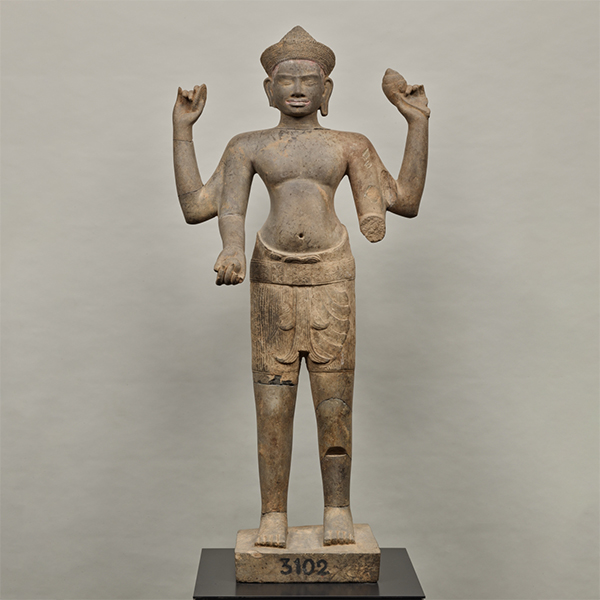クメールの彫刻
-

ヴィシュヌ立像 カンボジア、プラサット・オロックフランス極東学院交換品 アンコール時代・12世紀
東洋館 11室
2023年4月11日(火) ~ 2024年4月7日(日)現在のカンボジアにおいて、9世紀初頭から600年余り続いたアンコール王朝の時代には、クメール族による独特の美術様式が完成しました。中でも11世紀末から12世紀にかけて造られたアンコール・ワットがその最盛期です。この部屋では10~13世紀にアンコールの寺院を飾った仏教およびヒンドゥー教の彫像、浮彫の建築装飾をはじめとする石造彫刻を展示します。いずれも第2次世界大戦中におこなわれた、フランス極東学院との交換品です。
| 指定 | 名称 | 員数 | 作者・出土・伝来 | 時代・年代世紀 | 所蔵者・寄贈者・列品番号 | 備考 | |
| おすすめ | ナーガ上のガルダ | 1組(5個) | カンボジア、バプーオン入口と象のテラス フランス極東学院交換品 | アンコール時代・12~13世紀 | TC-404 | ||
| ガネーシャ坐像 | 1躯 | カンボジア、ブッダのテラス北側 フランス極東学院交換品 | アンコール時代・12~13世紀 | TC-403 | |||
| 男神立像 | 1躯 | カンボジア、タ・ケオ フランス極東学院交換品 | アンコール時代・12世紀 | TC-381 | |||
| おすすめ | ヴィシュヌ立像 | 1躯 | カンボジア、プラサット・オロック フランス極東学院交換品 | アンコール時代・12世紀 | TC-382 | ||
| 獅子 | 1躯 | カンボジア、癩王のテラス フランス極東学院交換品 | アンコール時代・12~13世紀 | TC-402 | |||
| おすすめ | ナーガ上の仏陀坐像 | 1躯 | カンボジア、アンコール・トム東南部のテラス№61 フランス極東学院交換品 | アンコール時代・12世紀 | TC-378 | ||
| 女神立像 | 1躯 | カンボジア、プレア・コー フランス極東学院交換品 | アンコール時代・11~12世紀 | TC-400 | |||
| おすすめ | 観音菩薩立像 | 1躯 | カンボジア、アンコール・トム死者の門 フランス極東学院交換品 | アンコール時代・12~13世紀 | TC-407 | ||
| 楣 | 1基 | カンボジア、タ・セル フランス極東学院交換品 | アンコール時代・11世紀 | TC-398 | |||
| 浮彫アプサラス像 | 1組(2個) | カンボジア、バイヨン フランス極東学院交換品 | アンコール時代・12~13世紀 | TC-401 | |||
| 浮彫人物像 | 1個 | カンボジア、バイヨン フランス極東学院交換品 | アンコール時代・12~13世紀 | TC-405 | |||
| 浮彫人物像 | 1個 | カンボジア、ピミアナカス フランス極東学院交換品 | アンコール時代・12世紀 | TC-406 | |||
| 九曜像 | 1基 | カンボジア、ネアック・タ・コン・スロック フランス極東学院交換品 | アンコール時代・11~12世紀 | TC-396 | |||
| 仏陀坐像 | 1基 | カンボジア、アンコール・トム東南部のテラス№65 フランス極東学院交換品 | アンコール時代・12~13世紀 | TC-379 | |||
| 仏陀三尊像 | 1基 | カンボジア、アンコール フランス極東学院交換品 | アンコール時代・12~13世紀 | TC-380 | |||
| 仏陀坐像 | 1基 | カンボジア、アンコール・ワット フランス極東学院交換品 | アンコール時代・12世紀 | TC-399 | |||
| おすすめ | 楣 | 1基 | カンボジア、プラサート・スララウ フランス極東学院交換品 | アンコール時代・10世紀 | TC-397 | ||
| 楣 | 1基 | カンボジア、プラサット・クドン フランス極東学院交換品 | アンコール時代・10世紀 | TC-395 |
